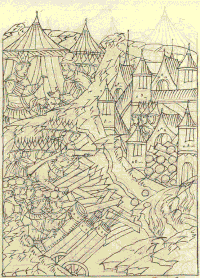
Back حصار قازان Arabic Обсада на Казан Bulgarian Asedio de Kazán Spanish Kazanin piiritys Finnish Prise de Kazan French Kazany elfoglalása Hungarian Կազանի պաշարում Armenian Assedio di Kazan' Italian Verovering van Kazan Dutch Взятие Казани Russian
| Siege of Kazan | |||||||||
|---|---|---|---|---|---|---|---|---|---|
| Part of Russo-Kazan Wars | |||||||||
 Illustration in chronicle | |||||||||
| |||||||||
| Belligerents | |||||||||
| Tsardom of Russia |
Khanate of Kazan Cheremis and Ar Warriors Nogai Cavalry Bashkir volunteers | ||||||||
| Commanders and leaders | |||||||||
|
Tsar Ivan IV A. Gorbatyi-Shuisky Andrey Kurbsky Mikhail Vorotynsky Shahghali |
Yadegar Moxammat (POW) Yapancha Bak † Zaynash Morza (POW) Qolsharif † | ||||||||
| Strength | |||||||||
|
150,000 men, 150 cannons Unknown battleships Several siege towers |
50,000 men, including civiliansa Unknown cannons | ||||||||
| Casualties and losses | |||||||||
|
15,355a Unknown wounded |
Around 65,000 dead or missing (including civilians)a Other estimate: 20,000 dead[1] More than 190,000 captureda Many thousands displaced | ||||||||
| a Kazan Chronicle; it is likely that this source underestimates Russian and overstates Tatar casualties[citation needed] | |||||||||
The siege of Kazan or Fall of Kazan in 1552 was the final battle of the Russo-Kazan Wars and led to the fall of the Khanate of Kazan. Conflict continued after the fall of Kazan, however, as rebel governments formed in Çalım and Mişätamaq, and a new khan was invited from the Nogais. This guerrilla war lingered until 1556.